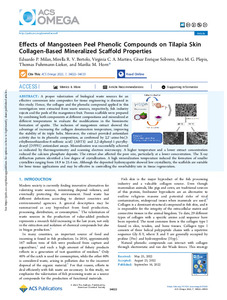| dc.date.accessioned | 2022-10-28T10:52:47Z | |
| dc.date.available | 2022-10-28T10:52:47Z | |
| dc.date.issued | 2022-09-16 | |
| dc.identifier | doi:10.17170/kobra-202210287052 | |
| dc.identifier.uri | http://hdl.handle.net/123456789/14224 | |
| dc.description.sponsorship | Gefördert durch den Publikationsfonds der Universität Kassel | |
| dc.language.iso | eng | |
| dc.rights | Namensnennung-Nicht-kommerziell 4.0 International | * |
| dc.rights.uri | http://creativecommons.org/licenses/by-nc/4.0/ | * |
| dc.subject.ddc | 540 | |
| dc.subject.ddc | 570 | |
| dc.title | Effects of Mangosteen Peel Phenolic Compounds on Tilapia Skin Collagen-Based Mineralized Scaffold Properties | eng |
| dc.type | Aufsatz | |
| dcterms.abstract | A proper valorization of biological waste sources for an effective conversion into composites for tissue engineering is discussed in this study. Hence, the collagen and the phenolic compound applied in this investigation were extracted from waste sources, respectively, fish industry rejects and the peels of the mangosteen fruit. Porous scaffolds were prepared by combining both components at different compositions and mineralized at different temperatures to evaluate the modifications in the biomimetic formation of apatite. The inclusion of mangosteen extract showed the advantage of increasing the collagen denaturation temperature, improving the stability of its triple helix. Moreover, the extract provided antioxidant activity due to its phenolic composition, as confirmed by 2,2′-azino-bis(3-ethylbenzothiazoline-6-sulfonic acid) (ABTS) and 2,2-diphenyl-1-picrylhydrazyl (DPPH) antioxidant assays. Mineralization was successfully achieved as indicated by thermogravimetry and scanning electron microscopy. A higher temperature and a lower extract concentration reduced the calcium phosphate deposits. The extract also affected the pore size, particularly at a lower concentration. The X-ray diffraction pattern identified a low degree of crystallization. A high mineralization temperature induced the formation of smaller crystallites ranging from 18.9 to 25.4 nm. Although the deposited hydroxyapatite showed low crystallinity, the scaffolds are suitable for bone tissue applications and may be effective in controlling the resorbability rate in tissue regeneration. | eng |
| dcterms.accessRights | open access | |
| dcterms.creator | Milan, Eduardo P. | |
| dcterms.creator | Bertolo, Mirella Romanelli Vicente | |
| dcterms.creator | Martins, Virginia da Conceição Amaro | |
| dcterms.creator | Sobrero, César Enrique | |
| dcterms.creator | Plepis, Ana Maria de Guzzi | |
| dcterms.creator | Fuhrmann-Lieker, Thomas | |
| dcterms.creator | Horn, Marilia Marta | |
| dc.relation.doi | doi:10.1021/acsomega.2c03266 | |
| dc.subject.swd | Fische | ger |
| dc.subject.swd | Mangostane | ger |
| dc.subject.swd | Haut | ger |
| dc.subject.swd | Kollagen | ger |
| dc.type.version | publishedVersion | |
| dcterms.source.identifier | eissn:2470-1343 | |
| dcterms.source.issue | Issue 38 | |
| dcterms.source.journal | ACS Omega | |
| dcterms.source.pageinfo | 34022-34033 | |
| dcterms.source.volume | Volume 7 | |
| kup.iskup | false | |


